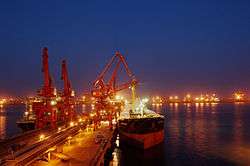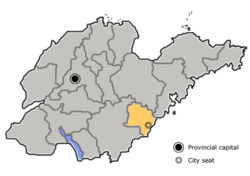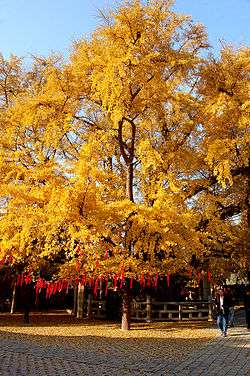Rizhao
Rizhao (Chinese: 日照), alternatively romanized as Jihchao, is a prefecture-level city in southeastern Shandong province, China. It is situated on the coastline along the Yellow Sea, and features a major seaport. It borders Qingdao to the northeast, Weifang to the north, Linyi to the west and southwest, and faces Korea and Japan across the Yellow Sea to the east.
Rizhao 日照市 Jihchao | |
|---|---|
 Rizhao Seaport | |
 Location of Rizhao City jurisdiction in Shandong | |
| Coordinates (Rizhao municipal government): 35°25′01″N 119°31′37″E | |
| Country | People's Republic of China |
| Province | Shandong |
| County-level divisions | 4 |
| Municipal seat | Donggang District |
| Government | |
| • CPC Secretary | Yang Jun (杨军) |
| • Mayor | Li Tongdao (李同道) |
| Area | |
| • Prefecture-level city | 5,310 km2 (2,050 sq mi) |
| • Urban | 1,915 km2 (739 sq mi) |
| • Metro | 1,507 km2 (582 sq mi) |
| Population (2010 census) | |
| • Prefecture-level city | 2,801,100 |
| • Density | 530/km2 (1,400/sq mi) |
| • Urban | 1,143,078 |
| • Urban density | 600/km2 (1,500/sq mi) |
| • Metro | 865,032 |
| • Metro density | 570/km2 (1,500/sq mi) |
| Time zone | UTC+8 (China Standard) |
| Area code(s) | 0633 |
| ISO 3166 code | CN-SD-11 |
| License Plate Prefix | 鲁L |
| Rizhao | |||||||||||||||||||||||
|---|---|---|---|---|---|---|---|---|---|---|---|---|---|---|---|---|---|---|---|---|---|---|---|
| Chinese | 日照 | ||||||||||||||||||||||
| Literal meaning | "Sunshine" | ||||||||||||||||||||||
| |||||||||||||||||||||||
The name of the city literally means "sunshine".[1] The city is known for its sustainability, and it mandates solar-water heaters in all new buildings. Rizhao city was recognized by the United Nations as one of the most habitable cities in the world in 2009.
The city population stands at 2,801,100 as of the 2010 census. Out of those, a little over 865,000 people live in the urban area of Donggang District.
History
Rizhao is located at the place where the ancient Dawenkou culture and the Longshan culture flourished. Rizhao belonged to the Dongyi people during the Xia and Shang dynasties (2070-1046 BC), and to Ju and Yue states in the Spring and Autumn period (770-476 BC) and the Warring States period (476-221 BC). It became a part of Langye Commandery in the Qin dynasty (221-206 BC). Rizhao was named Haiqu County (海曲縣) during the Western Han (206 BC-25 AD) and Xihai County under the Eastern Han (25-220 AD).
During the Tang dynasty, together with Ju County, Rizhao belonged to Mi Prefecture of Henan Prefecture. In the second year of the Yuanyou Period of the Song dynasty, Rizhao Township was established, with the name meaning "(the first to get) sunshine". In the 24th year of the Dading Period of the Jin dynasty, Rizhao County was established. In 1940 it came under control of the Communist Party of China. After being a county and since 1985 a city under administration of Linyi, Rizhao became a prefecture-level city within Shandong province in 1989.
The Field Museum of Natural History in Chicago has done field survey archaeological work in Rizhao over years.[2]
Climate
Rizhao has a temperate, four-season, monsoon-influenced climate that lies in the transition between the humid subtropical (Köppen Cwa) and humid continental (Köppen Dwa) regimes, but favoring the former. Winter is cool to cold and windy, but generally dry, with a January average of −0.3 °C (31.5 °F). Summer is generally hot and humid, but very hot days are rare, with an August average of 25.7 °C (78.3 °F). Due to its proximity to the coast and being on a peninsula, it experiences a one-month delayed spring compared to much of the province. Conversely, fall is milder than inland areas in Shandong. The annual mean temperature is 12.95 °C (55.3 °F). On average, there are 2,530 hours of bright sunshine annually and the relative humidity is 70–74 %.
| Climate data for Rizhao (1971–2000) | |||||||||||||
|---|---|---|---|---|---|---|---|---|---|---|---|---|---|
| Month | Jan | Feb | Mar | Apr | May | Jun | Jul | Aug | Sep | Oct | Nov | Dec | Year |
| Record high °C (°F) | 14.6 (58.3) |
19.0 (66.2) |
22.2 (72.0) |
31.1 (88.0) |
35.7 (96.3) |
38.3 (100.9) |
37.9 (100.2) |
35.4 (95.7) |
35.6 (96.1) |
30.2 (86.4) |
24.6 (76.3) |
17.9 (64.2) |
38.3 (100.9) |
| Average high °C (°F) | 3.7 (38.7) |
5.3 (41.5) |
9.4 (48.9) |
15.6 (60.1) |
20.8 (69.4) |
24.4 (75.9) |
27.7 (81.9) |
28.6 (83.5) |
25.5 (77.9) |
20.3 (68.5) |
13.0 (55.4) |
6.5 (43.7) |
16.7 (62.1) |
| Daily mean °C (°F) | −0.3 (31.5) |
1.2 (34.2) |
5.5 (41.9) |
11.5 (52.7) |
16.9 (62.4) |
21.2 (70.2) |
25.1 (77.2) |
25.7 (78.3) |
21.8 (71.2) |
16.0 (60.8) |
8.6 (47.5) |
2.2 (36.0) |
12.9 (55.3) |
| Average low °C (°F) | −3.7 (25.3) |
−2.0 (28.4) |
2.2 (36.0) |
8.2 (46.8) |
13.6 (56.5) |
18.6 (65.5) |
22.8 (73.0) |
23.0 (73.4) |
18.1 (64.6) |
12.0 (53.6) |
4.8 (40.6) |
−1.3 (29.7) |
9.7 (49.5) |
| Record low °C (°F) | −13.8 (7.2) |
−12.6 (9.3) |
−7.1 (19.2) |
−2.5 (27.5) |
5.9 (42.6) |
11.5 (52.7) |
14.9 (58.8) |
16.4 (61.5) |
9.4 (48.9) |
0.5 (32.9) |
−7.2 (19.0) |
−12.2 (10.0) |
−13.8 (7.2) |
| Average precipitation mm (inches) | 13.5 (0.53) |
17.8 (0.70) |
25.2 (0.99) |
41.4 (1.63) |
66.4 (2.61) |
102.1 (4.02) |
188.8 (7.43) |
161.7 (6.37) |
78.0 (3.07) |
48.4 (1.91) |
29.9 (1.18) |
11.3 (0.44) |
784.5 (30.88) |
| Average precipitation days (≥ 0.1 mm) | 3.3 | 4.2 | 5.4 | 6.9 | 8.3 | 9.1 | 13.6 | 11.0 | 7.5 | 6.1 | 5.1 | 3.3 | 83.8 |
| Source: Weather China | |||||||||||||
Administration
The prefecture-level city of Rizhao administers four county-level divisions, including two districts and two counties.
- Donggang District (东港区)
- Lanshan District (岚山区)
- Ju County (莒县)
- Wulian County (五莲县)
| Map |
|---|
Landmarks and tourist attractions
The following locations have a 4-star rating according to Chinese classification for scenic spots (旅游景区质量等级)
- Wulian Mountain (五莲山风景区)
- Fulai Mountain (浮来山风景区)
- Daqing Mountain (大青山风景区)
- Wanpingkou Beach (万平口风景区)
- Rizhao Beach National Park (日照海滨国家森林公园)
- Longmengu (龙门崮风景区)
- Liujiawan Park (刘家湾赶海园)
Sustainable development
The city now mandates the incorporation of solar panels in all new buildings, and oversees the construction process to ensure the panels are correctly installed.[3] The effort to install solar water heaters began in 1992. As of 2007, 99 percent of households in the central districts use solar water heaters, and most of the lighting and traffic signals are powered with photovoltaic solar power. In 2007 the city had over a half-million square meters of solar water heating panels, which have effectively reduced conventional electricity usage by 348 million kilowatthours per year. The city has been designated as the Environmental Protection Model City by China's SEPA, and is consistently listed in the top 10 cities for air quality in China.
Transportation
Rizhao features a major seaport, located approximately 620 km (390 mi) north of Shanghai, 170 km (110 mi) southwest of Qingdao, and 120 km (75 mi) north of Lianyungang. The seaport serves as a site for loading and unloading iron ore and coal. Other products passing through the harbor include cement, nickel, bauxite, and the like.[4] In 2011 the Port of Rizhao, together with the cities of Qingdao, Weihai and Yantai in Shandong, signed a strategic alliance with Busan, the largest port of the Republic of Korea. The alliance aims at building a shipping and logistics center in Northeast Asia.[5] The new iron ore port of Lanqiao is located close to it as is the Lanshan port region.[6]
Rizhao Shanzihe Airport (IATA: RIZ) is an airport serving the city of Rizhao. The airport received approval from the State Council and the Central Military Commission in October 2013. It is located in the town of Houcun (后村镇), Donggang District. It was opened on 22 December 2015.
The city is served by two railway stations, Rizhao railway station for local trains and Rizhao West railway station for both local and high speed services.
Education
Universities and colleges
Since becoming a city, Rizhao has seen a big growth in the number of universities and colleges, all of which are located in or near the University City (大学城) of Donggang District.
Image gallery
 Wanpingkou Beach
Wanpingkou Beach Fulaishan
Fulaishan Dengta Lighthouse
Dengta Lighthouse Wulian Mountain
Wulian Mountain
References
- Worldwatch Institute. (2007). State of the World : Our Urban Future.:108
- http://archive.fieldmuseum.org/expeditions/china6_expedition/about.html
- Levinson, Matthew and Chen, Jing, ", 2008-05-01.China — the rise of the green city", ScienceAlert Australia and New Zealand, retrieved on 2008-08-23
- http://www.researchandmarkets.com/reports/613350/china_company_report_rizhao_port_co_ltd
- "Four Chinese ports ally with ROK's largest port". Marine News China. 29 September 2011. Retrieved September 14, 2012.
- Guide to port entry. IHS Guides. 1 January 2017.
External links
| Wikimedia Commons has media related to Rizhao. |
| Wikivoyage has a travel guide for Rizhao. |
- Government website of Rizhao (in Chinese), retrieved on 2012-10-11
